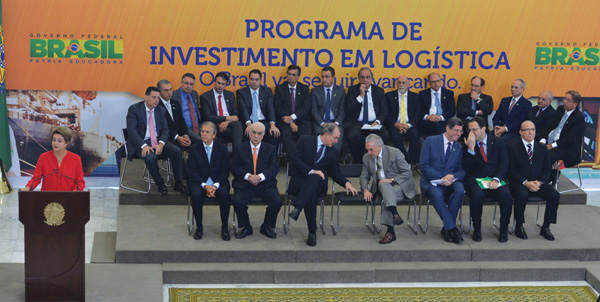China rail project a boost to Brazil's infrastructure
 |
|
Brazil's President Dilma Rousseff presented her government's Logistics Investment Program on June 6 in Brasilia. Agencia Brasil |
Brazilian President Dilma Rousseff has unveiled a major infrastructure improvement plan for the country's railroads, highways, airports and ports, including the China-backed transcontinental railway project.
On June 6 in Brasilia, Rousseff presented her government's Logistics Investment Program, which is an updated version of a plan launched in 2012 to spur economic growth.
"Over the coming years, Brazil's transport sector will see an investment of some 198.4 billion reals ($64 billion) to modernize the country's airports, highways, trains and ports," the official government website reported.
In her speech, Rousseff highlighted the importance of the proposed transcontinental railway between Brazil and Peru to improve Brazil's trade prospects.
"By linking the Atlantic to the Pacific, Brazil gains special access to the Asian markets, and given international trade transactions, that represents something extremely strategic," she said. "The expansion of Brazil's rail network is essential to becoming more efficient and relieving the burden of cargo transport by land."
She also highlighted China's extensive experience in railway building, saying it is something Brazil lacks because it has undertaken few rail projects in the past 30 years. Brazil's railway network, which is mainly in the south, southeast and northeast of the country, accounts for only 24 percent of the total capacity of the nation's current transportation system. About 35 percent of the railway system was built 60 years ago. The propose rail link connecting Brazil's Atlantic coast with Peru's Pacific coast would cross the agricultural heartland of Mato Grosso State, State of Para rich in mining resources.
It would create a South American trade corridor to make it easier for Brazil, China's main trading partner in Latin America, to export products to China, without having to go through the Panama Canal to the north.
According to the infrastructure program, the total investment in rail transportation amounts to 86.4 billion reals ($27.8 million).
The coast-to-coast railway was one of the main cooperation projects between China and Latin America promoted by Chinese Premier Li Keqiang during his four-nation tour of South America in May, which included Peru, the Pacific terminal of the proposed railway.
The three countries have agreed to speed up work of their joint working group to make early and substantial progress on the project to drive economic development along the railway line and accelerate industrialization and urbanization in South America while respecting environmental protection, Li told reporters after talks with Peruvian President Ollanta Humala in May.
Construction of the railway line will be significant to Peru, Brazil and China, as well as the regional economy, and China's participation is indispensable, Humala said.
Li said China has accumulated a great deal of experience in railway construction, and Chinese-made equipment has withstood the test of international market competition with a high safety record and cost performance ratios.
A joint feasibility study on the proposed railway is expected to be ready by May 2016 and environment protection will be a priority.
The transcontinental railway project is expected to boost the integration of South America.
"Due to the barrier of the Andes, the Southern Common Market and the Pacific Alliance, two major regional trading zones, haven't been able to cooperate enough ...," said Marne Lieggio Junior, an official at Brazil's Ministry of Transport. "The transcontinental railway will make a difference and establish closer links within the zones if completed."
Bolivian President Evo Morales said that the railway will not only link the two oceans, but also connect the Paraguay and the Parana rivers, two main water transportation systems in the region, that will benefit most South American countries.
An official from Paraguay said Paraguay, Argentina and Uruguay will also benefit if the project is completed.
"Railway transportation would definitely save time and money compared with that of freighters," said Oscar Gonzalez Drakeford, president of the Industry, Trade, Tourism and Cooperative Commission at Paraguay's House of Representatives.
Valdemar Carneiro Leao, Brazil's ambassador to China, said that this project will yield win-win results for all parties involved. "It will boost Brazil's exports by connecting Brazil to the Asian market and cutting transportation costs. China can also get those products at lower prices," Leao said.
The railway will bring 21 million tons of cargo to Peruvian ports for the Asian market at its initial operation, and in the long run, the number is expected be more than 35 million tons, according to estimates from Peru's government.
Bilateral trade between China and the Latin American and Caribbean countries in 2014 was $263.6 billion, up 0.8 percent year on year, according to Ministry of Commerce data.
Both sides aim to double the annual trade volume to $500 billion in 10 years and China has promised to increase investment in the region to$250 billion during the same period.
























